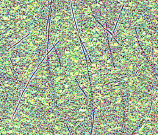Mar 30, 2003March 31, 2003 - Inkode, a Vienna, Virginia, company that has the license for a chipless RFID technology, is working with partners to develop applications for protecting high-value items in supermarkets, such as meats. The company says its tags can be mass-produced for less than a penny.
The Inkode system involves embedding very tiny metal fibers in paper, plastic and other materials that radio frequency waves can penetrate. The fibers reflect radio waves back to the reader, forming what Inkode calls a "resonant signature." These can be converted into a unique serial number.
The big advantage of the system is that it costs very little to add the fibers to paper, label stock or cardboard packaging. The tags can be read from less than an inch to 10 feet away. The readers operate at either 24 to 25 GHz or 60 to 66 GHz and cost about $200 and up, depending on the application.
Inkode has been selling this technology for about five years. Lintec Corp. of Japan has been manufacturing chipless RF tags under an agreement with Inkode. Inkode CEO Mort Greene says his company will ship more than 80 million tags this year to a pharmaceutical company using the chipless tags for brand protection.
Greene says he wants to partner with other company's to develop mass-market applications where companies need more than conventional bar code. "By embedding our fibers in the paper the bar code is printed on, you can create a unique serial number," he says. "That serial number can be linked to information in a database, so you the store knows when the product was received, when it expires and so on."
One company Inkode is working with is Chaotic.com, which develops products for detecting RF signals in challenging environments. Chaotic did some market research and determined that two possible applications are protecting high-value items in supermarkets and protecting and authenticating documents.
"Fifteen percent of supermarket sales is meat and produce, but those categories account for 30 percent of the profit," says Ted Frison, founder of Chaotic. "They are also what people steal. If you can protect those items, you can almost double your profit in the typical supermarket."
Chaotic is looking to develop a prototype system. The idea is to embed the fibers in the labels used on meats and other expensive items. There would be a reader at the checkout counter, but another reader below the conveyor could catch items being hidden under raincoats or in strollers.
Because the fibers are small and can be hidden in the paper, they can be used on pharmaceutical labels as a way of authenticating drugs. Another potential option is to embed them in important documents, such as confidential anti-terrorism files, or even municipal bonds and other financial documents.
Greene says that Ricoh is creating a module that can be added to its AFCIO copier that would detect the fibers. Companies and government agencies could use the technology to prevent the unauthorized copying of documents. Readers could be set up in doorways, hallways and exits to prevent people from leaving a building with sensitive documents.
One weakness is the resonant signatures of two or more tags in the same field can interfere with one another, preventing the reader from converting the signatures into the right serial number. And the system is read-only. So readers have to be tied into an IT infrastructure that can associate the unique serial number with information in a database. Inkode is looking to license its technology to partners who will develop complete solutions.


